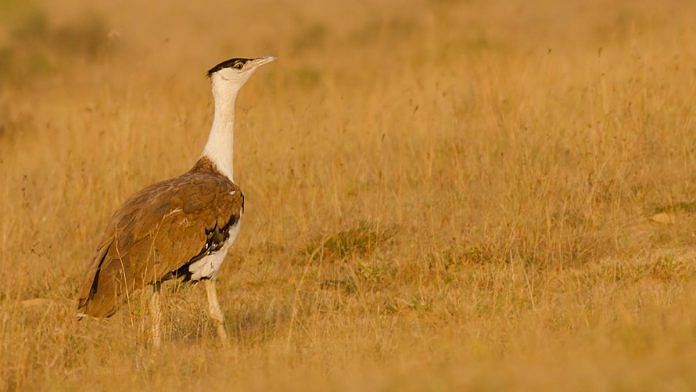SANDHYA RAMESH
Hunting of Asian houbara bustard, a vulnerable species, is banned in Pakistan, but is used as something of a foreign policy instrument since Arab royals are allowed to do so. Over the past weekend, 11 members of the UAE royal family reportedly arrived in Pakistan — with hunting gear and falcons — to hunt down the houbara bustard.The Asian houbara bustard, also known as MacQueen’s bustard (Chlamydotis macqueenii), is a vulnerable species and its hunting is banned in Pakistan, but an exception is made for Arab royals who are allowed to do so via special permits. The Asian houbara bustard is a bird native to Central Asia that migrates to the Indian subcontinent, including Pakistan, during winter months. It is one of multiple bustard species and similar to the Great Indian Bustard, which is native to India. The Arab royals hunt the bird as a sport and also because its meat is believed to be an aphrodisiac. The controversial practice of Arab royals being allowed to indulge in falconry was also followed in India until the 1970s, the target being the Great Indian Bustard.However, it was brought to an end amid a massive public outcry. Even so, the Great Indian Bustard remains critically endangered and faces imminent extinction risk if urgent intervention is not made.At great risk The Great Indian Bustard (GIB) or the Ardeotis nigriceps is one of the heaviest flying birds in the world, with an average adult male weighing 15 kg. The birds have long white necks and brown bodies with black and grey colouring. Males have a larger black crown and a black band across the breast. They are ostrich-like in appearance but smaller. The birds breed during the monsoon and have an omnivorous diet comprising seeds, insects, and even rats. They are native to grasslands and scrublands. Known locally as godawan, the GIB is found in Kutch (Gujarat), Solapur and Chandrapur (Maharashtra), Kurnool (Andhra Pradesh), Bellary (Karnataka), and in pockets of Rajasthan, primarily concentrated near the Desert National Park (DNP). It is now classified as critically endangered by the International Union for Conservation of Nature (IUCN) and has suffered a drastic drop in their numbers from hunting and loss of habitat. High-tension electricity wires that run along its flying route constitute one of the biggest threats to the Great Indian Bustard. Their numbers are believed to have dropped to 150 in 2018 from 1,260 in 1969. The Ministry of Environment and Forests and Climate Change, along with the Rajasthan government, the Wildlife Institute of India (WII), and Abu Dhabi’s International Fund for Houbara Conservation is currently undertaking a captive breeding project to save the GIB species. There are about 30 birds for now in their care, with the researchers looking to capture and incubate the eggs to ensure the health and safety of chicks. Conservationists have also called for power cables to be shifted underground or be covered with deflectors to prevent loss of life in this species. Conservation Over the past decades, many conservation projects have been launched for the GIB, the largest of which is the Desert National Park (DNP) in Jaisalmer. The DNP is spread over 3,000 square km in Jaisalmer and Barmer, and was established in 1980 to protect the desert ecosystem. Monitoring for bird safety is stringent in DNP. GIB eggs are at a risk of destruction from not just larger animals but also crows, so nests are intensely patrolled and water facilities provided for the birds. Poaching still persists in many countries.While the Wildlife Protection Act of 1972 made it illegal to hunt bustard, poaching continues to be a threat amid a demand for the bird’s meat. However, increased awareness among local residents has reportedly helped tackle poaching to some extent in the DNP area. The 75-odd villages surrounding the DNP area are actively involved in monitoring GIB individuals and population, while working with authorities to ensure their safety. ‘Policy’ on houbara bustard Hunting bustards is illegal in most countries. It was also banned completely in Pakistan by the country’s Supreme Court in 2015, but the decision was withdrawn in 2016 because the practice has become something of a foreign policy instrument for Pakistan. While official figures are not available, a 2016 BBC report quoted a Pakistan senator as saying that the “dignitaries who come to hunt the bird have not only established certain welfare projects but are also paying 10m Pakistani rupees [$95,000; £66,500] for hunting 50 birds in season”.

No comments:
Post a Comment